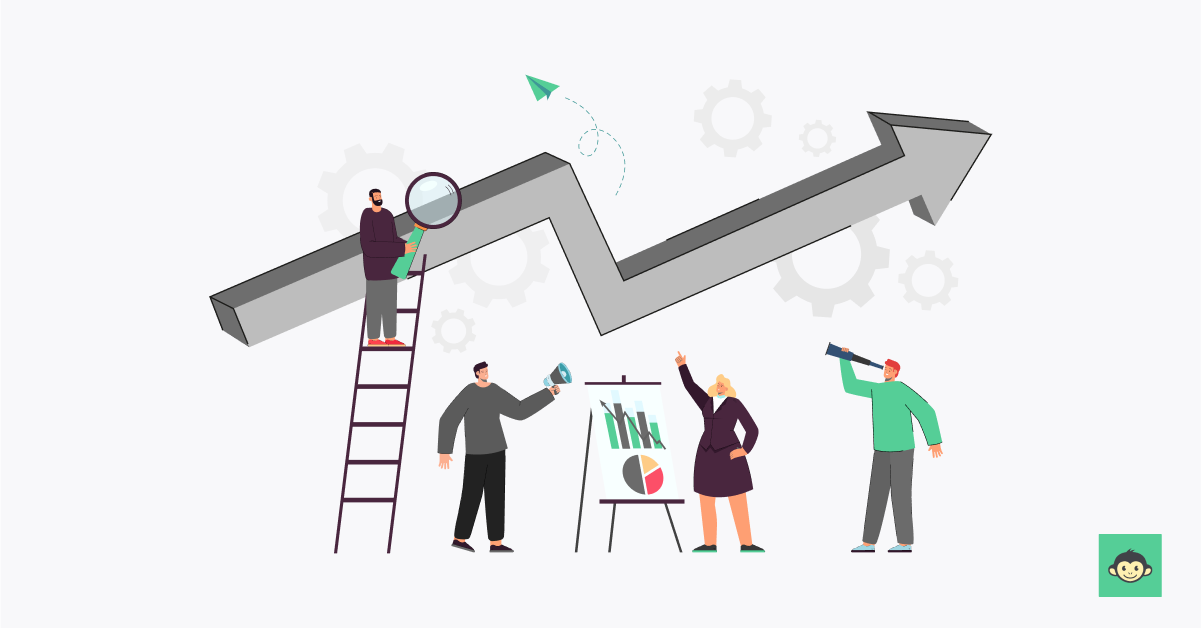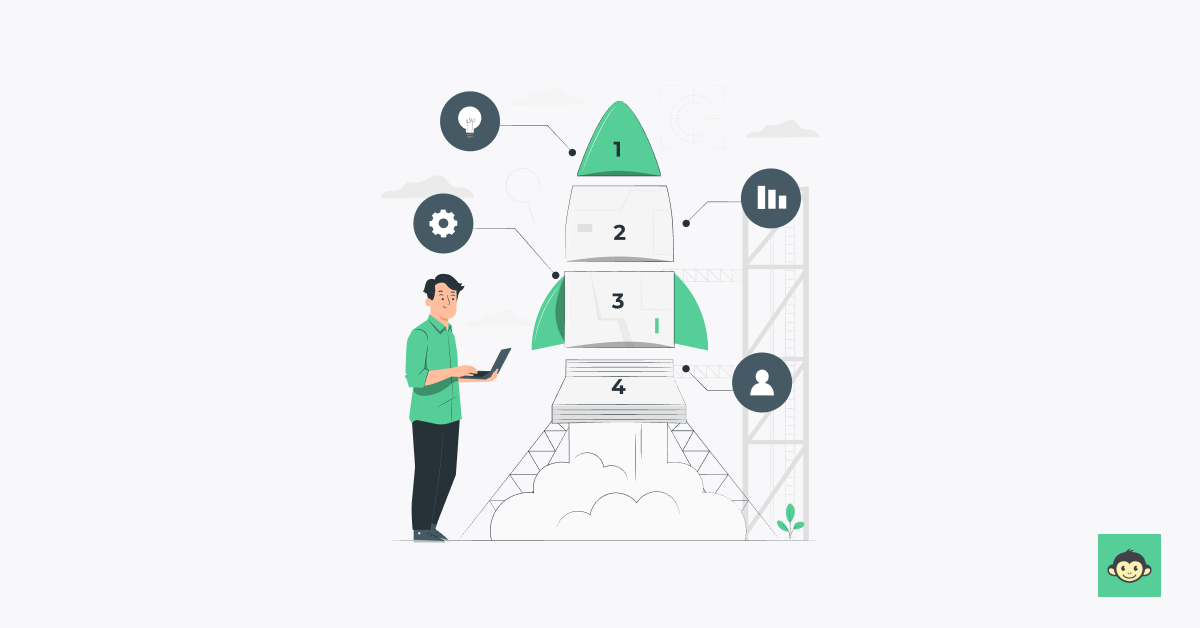How to build employee engagement at the workplace: Top tips to boost employee engagement in 2024

With remote work on the rise and the workforce becoming more diverse and dynamic, the need for effective employee engagement strategies has never been greater.
According to a recent study, only 36% of U.S. workers are engaged in their jobs. The challenges are clear, but so are the opportunities. Imagine a workplace where employees are not just motivated but truly inspired to contribute their best.
In this blog, we'll delve into the top tips and strategies to make this a reality. Get ready for a journey through the latest trends and creative techniques that will help you boost engagement, retain top talent, and create a workplace where people genuinely want to be.
Whether you're a manager, HR professional, or an employee eager to make a difference, these insights will empower you to build a more engaging work environment, because in 2023, employee engagement isn't just a buzzword; it's a game-changer.
What is employee engagement?

Employee engagement refers to the emotional commitment and connection employees have to their organization. It reflects the extent to which employees are enthusiastic about their work, dedicated to their roles, and willing to put in discretionary effort to help the company succeed.
Engaged employees feel a sense of purpose and pride in their work, and they often exhibit higher levels of productivity, creativity, and loyalty. Measuring employee engagement is crucial for organizations to understand their workforce's level of commitment.
Methods like surveys, one-on-one discussions, and feedback systems can help assess and improve employee engagement ideas. Companies that invest in fostering employee engagement tend to have higher retention rates, greater productivity, and improved overall performance, ultimately contributing to their success in a competitive business landscape.
Why should you care about employee engagement at work?

In essence, caring about employee engagement is not just a matter of boosting employee engagement satisfaction but is intrinsically linked to the success and longevity of the organization. Here are some reasons why you should care about employee engagement -
- Increased productivity: Engaged employees are more productive. They are motivated to perform their best, leading to higher efficiency and output.
- Higher quality work: Engaged employees take pride in their work, resulting in higher quality products or services. They pay attention to detail and consistently strive for excellence.
- Improved employee retention: Engaged employees are less likely to leave their jobs. When employees feel valued and connected to their work, they're more inclined to stay with the organization.
- Enhanced innovation: Engaged employees are more likely to contribute innovative ideas. They feel comfortable sharing their thoughts and believe that their ideas are heard and valued.
- Better customer service: Engaged employees are more likely to provide excellent customer service. They care about the company's reputation and are more likely to go the extra mile to satisfy customers.
- Stronger teamwork: Engaged employees work well with their colleagues. They collaborate effectively, share knowledge, and support each other in achieving common goals.
- Reduced absenteeism: Engaged employees are more committed to their work and less likely to be absent. They understand their role in the organization's success and are motivated to show up consistently.
- Enhanced well-being: Employee engagement is linked to improved mental health and overall well-being. Engaged employees experience less stress and are generally happier in their roles.
- Company reputation: A highly engaged workforce can boost the company's reputation. It's seen as an employer of choice, which attracts top talent.
- Financial performance: Engaged employees positively impact the company's financial performance. They drive growth, profitability, and sustainability.
10 Challenges for enabling engagement at work for your employees

Enabling engagement at work is a fundamental goal for any organization, but it comes with its fair share of challenges. Here are 10 creative points outlining those challenges:
- The never-ending email chain: Employees drowning in a sea of emails often struggle to find time for meaningful work, leading to disengagement. Overcoming this challenge requires streamlined communication tools and setting clear expectations for email usage.
- Meetings galore: Excessive and unproductive meetings can stifle engagement. Challenge: Implement the "Two Pizza Rule" from Amazon—only invite as many people to a meeting as you can feed with two pizzas.
- Toxic positivity: An overly optimistic work environment may discourage employees from expressing genuine concerns. Balancing positivity with a culture that values open and honest employee feedback is key.
- Cubicle catastrophe: Outdated office spaces can be uninspiring and hinder collaboration. Challenge: Redesign office layouts to encourage interaction, innovation, and creativity.
- Overloaded to-do lists: A never-ending workload leads to burnout and disengagement. Challenge: Encourage realistic task prioritization and work-life balance.
- Tech overload: Too many tools and software can overwhelm employees. Simplify and integrate tech solutions to enhance productivity and reduce confusion.
- Recognition deficit: Without proper acknowledgment, employees may feel undervalued. The challenge is to establish a culture of recognition and appreciation.
- Change fatigue: Frequent organizational changes can cause anxiety and disrupt engagement. Ensure clear communication about the reasons behind changes and provide support during transitions.
- Personal development stagnation: When employees feel their careers have hit a dead end, employee turnover and engagement drop. Challenge: Offer growth opportunities, mentorship, and training.
- Lack of diversity and inclusion: A homogeneous workplace discourages employees from bringing their authentic selves to work. Challenge: Promote diversity and inclusion to create a more engaging and innovative environment.
Overcoming these creative challenges can significantly boost employee engagement and create a more vibrant and productive workplace.
What are the 6 C's of employee engagement?

The "6 C's of Employee Engagement" represent key elements that contribute to a highly engaged workforce. These elements provide a framework for organizations to foster a positive and productive work environment:
- Connection: Building a strong connection involves establishing positive relationships between employees and their colleagues, managers, and the organization itself. A sense of belonging and camaraderie can help employees feel more engaged.
- Contribution: Employees need to feel that their contributions to the organization are meaningful and valued. When their work makes a difference, they are more likely to be engaged.
- Clarity: Clear communication about roles, expectations, and objectives is crucial. Employees should understand their responsibilities and how they fit into the broader goals of the organization.
- Caring: Organizations that demonstrate care for their employees' well-being, both personally and professionally, tend to have higher employee engagement surveys and levels. This includes providing support during difficult times and promoting work-life balance.
- Consistency: Consistency in leadership, policies, and decision-making fosters a sense of stability and trust. Employees are more engaged when they can rely on the organization to be fair and consistent.
- Congruence: Congruence refers to the alignment between individual values and those of the organization. When employees feel that their values align with the organization's mission and values, they are more likely to be engaged.
These "6 C's" are not isolated concepts; they are interrelated and work together to create a holistic approach to employee engagement. Organizations that prioritize these elements in their work culture are more likely to have a highly engaged and motivated workforce, leading to increased productivity, retention, and overall success.
What are the 5 important drivers of employee engagement?

Employee engagement is a multifaceted concept driven by various factors that contribute to an individual's commitment, motivation, and job satisfaction within an organization. Here are five important drivers of employee engagement, each with its unique characteristics:
1. Effective leadership
Strong and empathetic leadership is a cornerstone of employee engagement. Leaders who lead by example, communicate transparently, and actively listen to their teams foster trust and motivation to engage employees. They provide clear direction, offer growth opportunities, and empower employees to make decisions, leading to increased engagement.
2. Meaningful work
Employees are more engaged when they find their work purposeful and aligned with the organization's mission and company values. When they see how their efforts contribute to the bigger picture, they're more likely to stay motivated and committed.
3. Recognition and appreciation
Feeling valued and appreciated is a fundamental driver of engagement. Regular recognition for a job well done, whether through formal programs or a simple 'thank you,' boosts morale, enhances employee engagement and job satisfaction, and creates a positive work environment.
4. Opportunities for growth and development
Employees are more engaged when they have opportunities to learn, grow, and advance within the organization. Professional development, skill-building, and a clear career path give employees a sense of progress and investment in their future.
5. Work-life balance and well-being
Employee well-being, including physical and mental health, plays a crucial role in engagement. Organizations that promote work-life balance, offer flexible schedules, and provide support for employee well-being initiatives show they care about their staff beyond their productivity.
These drivers are interrelated and often reinforce one another. Effective leadership, for example, can lead to meaningful work and recognition, which, in turn, supports opportunities for growth and well-being. Together, these drivers create a holistic approach to fostering employee engagement and building a more productive and satisfied workforce.
How do you develop employee engagement?
Developing employee engagement is a multi-faceted process that requires a strategic approach. Here are five creative and unique steps to foster employee engagement:
- Personalized growth plans: Encourage employees to create personalized growth plans that align with their individual goals and the company's objectives. This approach allows them to take ownership of their development and feel more engaged in their roles.
- Peer recognition programs: Implement peer recognition programs where employees can acknowledge and appreciate the efforts of their colleagues. This not only boosts morale but also fosters a sense of belonging and camaraderie.
- Job crafting: Allow employees to tailor their job roles to match their strengths and passions. This job crafting approach empowers individuals to shape their roles, resulting in higher job satisfaction and engagement.
- Flexible work arrangements: Offer flexible work arrangements, such as remote work options or flexible hours, to provide employees with a better work-life balance. This flexibility can improve their overall well-being and increase employee engagement.
- Employee-led initiatives: Encourage employees to lead and participate in various initiatives, such as cross-functional teams, diversity and inclusion groups, or sustainability projects. These employee-led initiatives not only enhance employee engagement goals but also contribute to a sense of purpose.
By implementing these creative steps, organizations can proactively develop employee engagement, leading to a more motivated and committed workforce.
23 Tips to improve employee engagement at the workplace

Employee engagement is a crucial aspect of a productive and positive workplace. Here are 23 tips to enhance employee engagement:
01. Leadership engagement
Leadership engagement refers to the active participation and involvement of organizational leaders, including top-level executives, managers, and supervisors, in the daily operations and interactions with their employees.
It goes beyond traditional management roles and emphasizes leaders' willingness to listen, guide, and support their teams. Engaged leaders communicate effectively, set a positive example, and create an environment where employees feel valued, motivated, and connected to the company's mission and values.
Leadership engagement is a cornerstone of successful organizations, as it promotes trust, fosters a sense of belonging, and empowers employees to perform at their best, ultimately enhancing overall productivity and morale.
02. Clear communication
It is essential for improving employee engagement. It involves effectively transmitting information, expectations, and objectives within an organization. When leaders and managers communicate openly and honestly, employees feel more connected to the company's mission and values.
They understand their roles and responsibilities, which reduces confusion and fosters a sense of purpose. Clear communication also involves active listening, which makes employees feel heard and valued.
It allows for the resolution of issues and concerns and reinforces trust between management and staff. In an environment of clear communication, employees are more likely to be engaged, motivated, and committed to their work.
03. Recognition and appreciation
Recognition and appreciation are fundamental elements in enhancing employee engagement. This point emphasizes the importance of acknowledging and valuing the efforts and contributions of employees.
When managers and peers recognize the hard work and achievements of their colleagues, it not only boosts morale but also motivates individuals to continue performing at their best. Effective recognition programs can take various forms, from verbal praise and written commendations to awards and incentives.
By showing appreciation for their dedication and accomplishments, organizations create a positive and affirming workplace culture, which, in turn, leads to higher job satisfaction and improved overall employee engagement.
04. Feedback loops
Feedback loops refer to a crucial element in employee engagement and organizational improvement. These mechanisms are structured processes that allow employees to provide feedback on various aspects of their work, the company culture, and their overall experience.
The collected feedback can be both positive and constructive and often serves as a means for employees to express their opinions, share concerns, or highlight areas where improvement is needed.
Feedback loops are essential for organizations because they help in identifying issues early, making informed decisions, and ensuring that employees feel heard and valued, ultimately leading to a more engaged and productive workforce.
05. Training and development
It is a critical aspect of employee engagement and growth within an organization. It refers to the process of enhancing employees' skills, knowledge, and competencies through various learning opportunities.
These initiatives can include workshops, seminars, online courses, on-the-job training, mentoring, and more. Training and development not only improve individual performance but also contribute to organizational success.
It enables employees to stay up-to-date with industry trends, adapt to evolving technologies, and take on new challenges. Furthermore, investing in employees' professional growth demonstrates a commitment to their well-being, which can boost morale, loyalty, and employee satisfaction.
06. Wellness programs
Wellness programs are company initiatives designed to promote and support the physical and mental well-being of employees. These programs often include a range of activities and benefits such as fitness classes, nutrition guidance, stress management workshops, mental health resources, and incentives to adopt healthier lifestyles.
Wellness programs aim to enhance employees' overall health, reduce stress, improve work-life balance, and ultimately boost productivity. They not only benefit individual employees by helping them maintain good health but also contribute to a more positive work environment, decreased absenteeism, and increased job satisfaction, aligning with the organization's commitment to employee well-being.
07. Flexible work arrangements
Flexible work arrangements refer to policies and practices that enable employees to have more control over when, where, and how they work. This approach offers alternatives to the traditional 9-to-5 office routine, accommodating the diverse needs and preferences of the modern workforce.
Flexibility can include options like remote work, compressed workweeks, part-time schedules, job sharing, and adjusted start and end times. It allows employees to better balance their work and personal lives, reduces commuting stress, and often leads to increased job satisfaction and productivity.
Flexible work arrangements are increasingly vital in today's dynamic work environment, promoting work-life balance and accommodating individual needs.
08. Team building activities
Team building activities are designed to enhance collaboration, communication, and trust among team members. They involve various exercises or events that encourage employees to work together, often outside their regular work tasks.
These activities can range from problem-solving challenges and outdoor adventures to workshops and group discussions. The main goal is to strengthen relationships within a team, identify and address issues, and improve overall team performance.
Effective team-building activities can help create a positive work environment, increase employee morale, and boost productivity by fostering a sense of unity and shared purpose among team members.
09. Diversity and inclusion
Diversity and inclusion (D&I) is a strategic approach that recognizes, respects, and values the differences in individuals within an organization. It goes beyond merely acknowledging factors like race, gender, age, sexual orientation, and abilities.
D&I strives to create a workplace where all employees feel welcomed, respected, and empowered, irrespective of their backgrounds. Inclusivity is the active practice of ensuring that everyone has equal access to opportunities and resources, as well as a voice in decision-making processes.
Diversity, paired with inclusion, can lead to a more innovative, creative, and productive workforce while fostering a culture of equity and belonging.
10 .Conflict resolution
Conflict resolution refers to the process of addressing and settling disputes, disagreements, or conflicts constructively and peacefully. It involves finding a resolution that is acceptable to all parties involved, minimizing negative emotions, and maintaining or restoring positive relationships.
Effective conflict resolution often includes active listening, clear communication, empathy, and problem-solving skills. It is crucial in both personal and professional settings, as it helps prevent prolonged disputes, reduces tension, and allows individuals or groups to work together harmoniously.
Whether in a family, workplace, or international diplomacy, conflict resolution is essential for maintaining peace, understanding, and cooperation.
11. Empowerment
Empowerment is the process of granting individuals or groups the authority, autonomy, and resources to make decisions, take action, and control their destinies. It involves entrusting individuals with the responsibility to solve problems, make choices, and contribute to organizational or community goals.
Empowerment fosters a sense of ownership, accountability, and self-determination, enabling people to develop their skills, gain confidence, and have a stake in their success. It can occur within various contexts, such as the workplace, where employees are encouraged to make decisions, or in broader societal movements, where marginalized groups demand equal rights and opportunities to shape their futures.
12. Challenging assignments
Challenging assignments refer to tasks or projects that push employees out of their comfort zones and require them to utilize their skills and knowledge to their fullest potential.
These assignments are designed to be intellectually stimulating and demanding, encouraging employees to think creatively, problem-solve, and develop new competencies. By providing challenging work, organizations not only keep their employees engaged and motivated but also promote personal and professional growth.
When employees tackle assignments that are slightly beyond their current abilities, they experience a sense of accomplishment and gain the confidence to take on even more complex challenges, contributing to their overall job satisfaction and career development.
13. Well-defined goals
Well-defined goals are clear and specific objectives that employees understand and can work towards. These goals provide a roadmap for individual and team efforts, helping employees focus their energies effectively.
When goals are well-defined, employees know what's expected of them, how their contributions align with the organization's broader mission, and the criteria for success. Clarity in goal-setting enhances motivation, as employees can see their progress and contributions.
It also facilitates better performance evaluation, as achievements can be measured against predetermined targets. Ultimately, well-defined goals contribute to a more engaged and purpose-driven workforce.
14. Leadership training
Leadership training is a structured educational process aimed at enhancing an individual's leadership skills and capabilities. It encompasses a range of activities designed to develop qualities such as effective communication, decision-making, conflict resolution, and the ability to inspire and guide teams.
Leadership training equips individuals with the tools and knowledge to lead with confidence and effectiveness. This training can be particularly beneficial for aspiring or current leaders, managers, and executives, as it helps them adapt to evolving workplace dynamics, boost team morale, and drive organizational success through competent leadership.
It often includes workshops, coaching, mentoring, and self-assessment to refine leadership competencies.
15. Regular check-ins
Regular check-ins involve consistent one-on-one meetings between employees and their supervisors. These meetings serve as a platform for open communication, where employees can discuss their work progress, challenges, and aspirations.
Through regular check-ins, supervisors can provide guidance, offer feedback, and address any concerns, fostering a sense of support and recognition among the employees. These sessions are instrumental in building strong working relationships, boosting job satisfaction, and enhancing overall employee engagement.
They help align individual goals with organizational objectives and ensure that employees feel valued and heard, ultimately contributing to a more motivated and productive workforce.
16. Social responsibility
Social responsibility, often referred to as corporate social responsibility (CSR), is the ethical and moral obligation of organizations and businesses to contribute positively to society.
It entails actions and initiatives taken beyond profit generation and involves considering the broader impact of business operations on the environment, communities, and stakeholders. This concept reflects an organization's commitment to sustainable practices, philanthropy, and ethical conduct.
By engaging in social responsibility, companies aim to address social and environmental issues, promote fairness and inclusivity, and build a positive reputation, all while balancing profit motives with the betterment of society.
17. Mentorship programs
Mentorship programs are structured relationships between an experienced, knowledgeable mentor and a less-experienced mentee, designed to facilitate the mentee's personal and professional growth.
The mentor provides guidance, support, and knowledge sharing, helping the mentees acquire new skills, develop their careers, and navigate challenges. These programs typically encompass formal arrangements within organizations, but informal mentorships can also be highly effective.
Mentorship programs play a vital role in passing down knowledge, fostering talent development, improving employee engagement, and promoting diversity and inclusion. They are essential tools for building a skilled, motivated workforce and promoting professional growth.
18. Work-life balance
Work-life balance is a critical aspect of a person's overall well-being and quality of life. It refers to the equilibrium between one's professional responsibilities and personal life, encompassing family, health, and leisure activities.
Maintaining a healthy work-life balance is essential to prevent burnout, reduce stress, and nurture physical and mental health. It allows individuals to allocate time for personal interests, spend quality moments with loved ones, and recharge, ultimately enhancing their productivity and job satisfaction.
Striking the right balance ensures that work does not dominate one's life and enables one to lead fulfilling, harmonious lives.
19. Employee surveys
Employee surveys are a valuable tool for organizations seeking insights into their workforce's thoughts, feelings, and needs. These surveys involve posing questions to employees, gauging their opinions, and collecting data about their workplace experiences.
Employee surveys help organizations understand job satisfaction, identify areas for improvement, and make data-driven decisions. They can cover a wide range of topics, from work-life balance to leadership effectiveness.
The feedback gathered through these surveys empowers companies to refine policies, enhance employee engagement, boost productivity, and ultimately create a more positive and inclusive work environment. Employee surveys are a vital component of modern human resource management and organizational development.
20. Competitive benefits
Competitive benefits refer to the compensation and perks that an employer offers to attract, retain, and motivate top talent in a fiercely competitive job market. These benefits go beyond basic salary and may include healthcare coverage, retirement plans, paid time off, bonuses, stock options, flexible work arrangements, and other incentives.
Providing competitive benefits not only helps an organization stand out as an attractive employer but also ensures that employees feel valued and supported, which can boost their job satisfaction, loyalty, and overall performance. Companies that offer appealing, competitive benefits are more likely to attract and retain skilled professionals, driving their success in the long run.
21. Career pathing
It is a strategic approach to employee development and progression within an organization. It involves helping employees set clear, achievable career goals and charting a course to reach them. By identifying the necessary skills, experience, and training, organizations can provide employees with the tools and opportunities to advance in their careers.
Career pathing benefits both employees and the company, as it increases job satisfaction, motivation, and productivity, while also ensuring a pipeline of qualified talent for future leadership positions. It aligns individual aspirations with organizational goals, contributing to a more engaged and loyal workforce.
22. Recognition platforms
Recognition platforms are digital tools or software designed to facilitate and streamline the process of acknowledging and rewarding employees for their hard work and accomplishments.
These platforms provide a centralized space for managers and peers to publicly recognize and appreciate an employee's contributions. They often include features like peer-to-peer recognition, performance tracking, and rewards programs.
By making recognition more visible and accessible, these platforms boost employee morale, strengthen team cohesion, and create a culture of appreciation. They also offer data-driven insights into employee engagement, helping organizations tailor their recognition efforts and enhance overall job satisfaction.
23. Celebrations
"Celebrations" is a vital aspect of improving employee engagement within the workplace. It involves acknowledging and commemorating various achievements, milestones, and team successes. Celebrations can take various forms, such as work anniversaries, birthdays, project completions, or significant accomplishments.
These events are more than just parties; they are an opportunity to recognize employees' contributions, foster a positive work environment, and strengthen the sense of belonging within the team.
Celebrations boost morale, enhance camaraderie, and create memorable moments that employees cherish, making them feel valued and motivated, ultimately contributing to higher job satisfaction and engagement.
These strategies can vary depending on the company's culture and the unique needs of its employees. Nonetheless, fostering employee engagement will lead to a more satisfied, motivated, and productive workforce.
Conclusion
In the ever-evolving workplace of 2023, nurturing employee engagement is a dynamic challenge. However, by applying the top tips discussed here, organizations can pave the way for a more engaged, motivated, and productive workforce.
Embrace these strategies, encourage open communication, invest in professional development, and create a culture of recognition and inclusivity. With a proactive approach, you can unlock the full potential of your employees and achieve unprecedented success in the year ahead.
FAQs
1. What is employee engagement, and why is it crucial in 2023?
Employee engagement represents the depth of emotional commitment employees invest in their work and organization. In 2023, its significance extends beyond loyalty; it's a strategic lever for heightened productivity, innovation, and talent retention. As the business landscape evolves at an unprecedented pace, a highly engaged workforce stands as a pivotal differentiator, ensuring organizational resilience.
2. What are the top challenges to employee engagement in 2023?
Prominent challenges include grappling with the pervasive burnout associated with remote work, navigating communication hurdles in virtual settings, and preserving a sense of belonging among dispersed teams. Effectively addressing these hurdles is pivotal to sustaining robust employee engagement, as the workplace undergoes continuous transformations in 2023. Overcoming these challenges ensures organizations remain agile and responsive to the evolving dynamics.
3. How can I improve employee engagement in a remote work environment?
Elevating remote engagement requires a multifaceted approach. Prioritize transparent communication channels, creating opportunities for professional growth, and fostering a culture that supports a healthy work-life balance. Regular virtual check-ins go hand-in-hand with innovative team-building activities that transcend the digital barrier, creating a strong virtual community. These elements collectively contribute to sustaining robust connections in a remote work setting.
4. What role does leadership play in fostering employee engagement?
Leadership emerges as the linchpin in shaping the landscape of employee engagement. Effective leaders transcend mere management; they inspire trust, communicate transparently, and articulate a compelling vision that resonates with the workforce. Cultivating a positive work culture becomes their mission, significantly contributing to the overall engagement, satisfaction, and productivity of their team members.
5. What are some creative ways to recognize and reward employees for their engagement?
Infuse creativity into recognition by personalizing acknowledgments, hosting virtual celebrations, and highlighting achievements in team meetings. Innovative approaches, such as offering unique professional development opportunities, flexible work arrangements, and comprehensive wellness initiatives, not only recognize employees but also foster a culture of continuous engagement, contributing to a thriving and motivated workforce.



